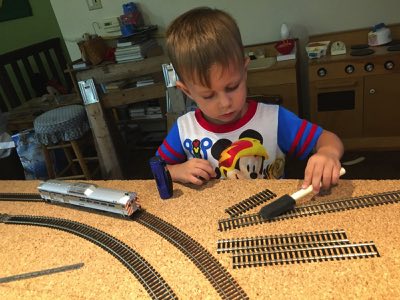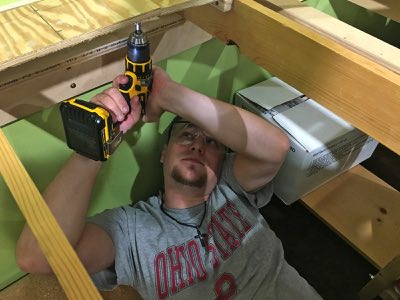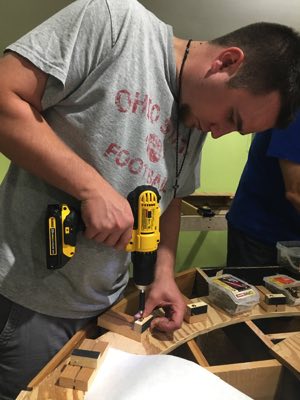July 19, 2018
|
|
|
Grandson Liam is staying with us for five days and therefore was able to join in the fun of our Thursday train night. Although the track is still not electrified he provides his own power to run an Alaska Railroad RDC. |
Plagiarism is the sincerest form of flattery. Daniel Humphrey posted photos of his double crossover on an HO scale modeling Facebook page. He was kind enough to shared his configuration (Atlas Code 100 #8 Mark IV switches and a 12.5 degree crossing) with us and we easily duplicated his effort. |
Mike uses a level for a straight edge to initially survey the configuration and thus verify plywood roadbed size and three-inch track centers.
|
|
|
 |
| One known facet of my life is if I can screw something up then I will. When I reordered track I mistakenly chose code 83 with brown ties instead of code 100 with black ties. One known facet of Tom's life is he can fix other people's mistakes. First, he drills center pilot holes through the ties for spike insertion. For some reason code 83 doesn't have pilot holes that go all the way through the ties. Later he will taper the rails of my existing code 100 track to feather into the smaller code 83 rails. |
I missed the last two train nights as Terry and I were on vacation. Tom kept himself busy by finishing the Anchorage yard and diesel shop stubs. He also ran the lines from the north end of the Anchorage yard to the swing gate. The ends are taped to prevent damage as workers pass through the swing gate opening. |
When it comes to building a layout you can never have too much help. Liam provided a critical function of cleaning track remnants with foam paint brushes. He also used the scale measure (at left) to ensure all track was within gauge. |
|
|
|
| Tom lays the track leaving the south end of the Anchorage yard. |
On a previous evening Mike and LJ laid the layout's first corkboard which was located at the southern end of the Anchorage yard. A tapering process had to be implemented as the Anchorage yard cork bed is 1/4" (at left) while the track cork bed (at right) is 3/16". |
Tom lays flex track through the Anchorage Sand and Gravel industry. |
|
 |
|
| The cleating process continues through the tunnel section. |
LJ gets a real workout putting the cleats in place for the double crossover. OSHA inspectors should note his use of safety glasses. |
Workers protect their hands using OSHA certified X Titan Alaska Railroad work gloves. |
July 26, 2018
|
|
|
As Tom and I sat at the kitchen table downstairs waiting for Terry to put the finishing touches on dinner he told me of a mistake made last week. He laid track into the swing gate area according to my pencil marks and not the published plans. The tracks do not run parallel, but merge together. He decided to return to the scene of the crime of fix his mistake before we all sat down to eat. |
Knowing the double crossover could be a source of future derailments Tom spent a great deal of time putting it together. |
After assembling all the pieces and tacking them in place he soldered everything together. First, he applied soldering paste with a small paint brush. |
|
 |
|
| Next, he soldered all the pieces together. He used a flat file and then .320 sand paper to ensure all rail top surfaces were smooth. The resultant effort created a single sturdy piece which could easily be relocated to the final location. |
LJ is screwing the cleats onto the risers for the TwentyMile bridge section. |
A close up view of cleat (top) being screwed onto the riser (bottom). |
|
|
|
| Leigh assisting with the cleat/riser assembly. |
The cleat/riser effort turns into an assembly line production. Mike applies total quality management principals learned from his MBA degree to ensure the best possible products. |
The RailModeler Pro software did a poor job of displaying track height at regular intervals along the run. The TwentyMile Bridge subdivision will rise six inches in 25 feet. Mike and his team interpolate this information to install the risers at the proper height.
|
 |
|
|
A close up view of L-girder construction to riser to cleat to roadbed. |
The CEO/Janitor is inspecting the cut curves to assure quality control. It is also good to know he can crawl under the table into the mountain access area to fix possible derailments. |
Tom is all energy tonight and works at the speed of a cheetah. He spreads Loctite 200 Projects Construction adhesive onto the plywood roadbed to hold the cork bed |
|
|
|
| Next he lays down the cork bed on top of the adhesive. |
Finally he tapes the cork bed in place. The adhesive will cure in 48 hours and the tape can removed and track installed. |
Tom lays cork bed through the double crossover. |
|
|
|
| The cork bed is again taped into place. |
The cork bed through the Tunnel subdivision/reverse loop is complete! |
It is so exciting seeing the completed TwentyMile Bridge riser section! Mike, LJ and Leigh did an incredible job! |
 |
|
|
Although Max braved the noise and stayed with us the entire evening he was less than thrilled with the loud booms from an incoming thunderstorm. |
|
|